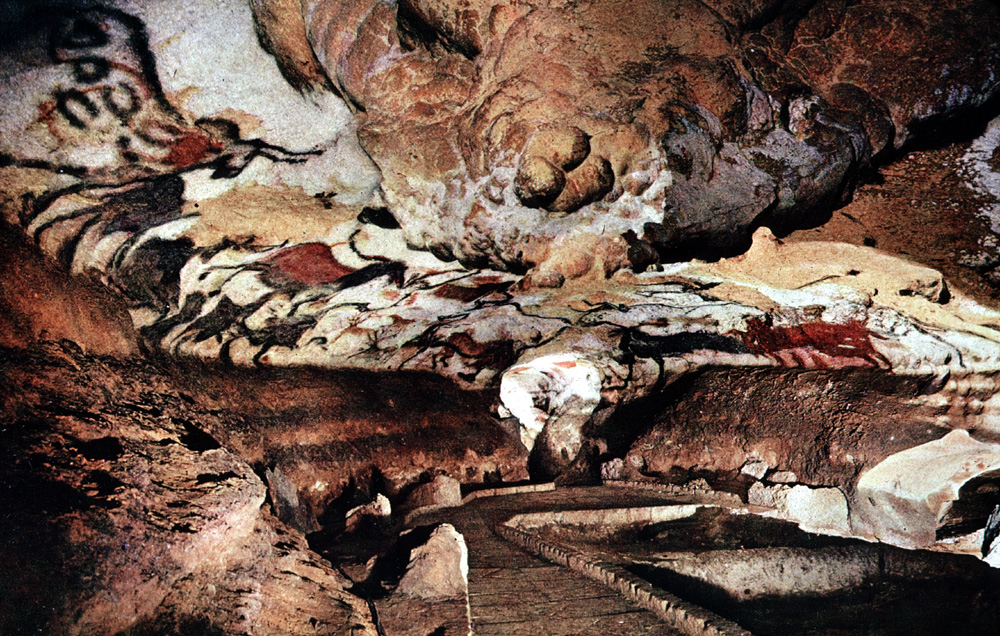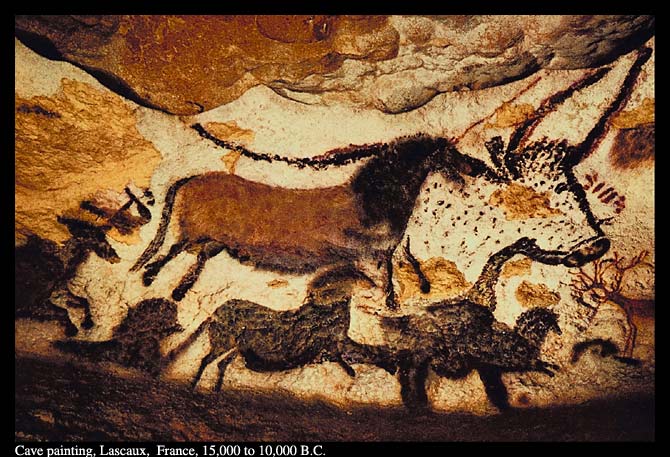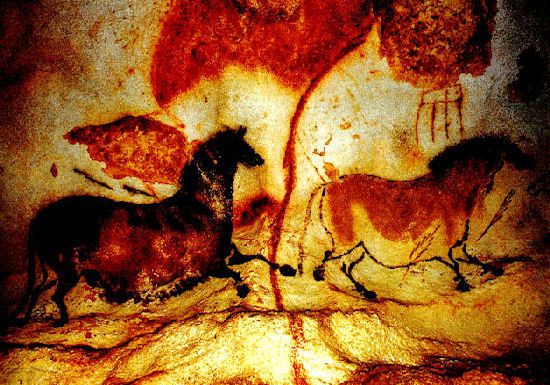|
|
|||||||||||||||||||||||||||||||||||||||||||
|
|
The Nagasawa family trip to France: May 1 - 15, 2011 Main Page, France trip May 2011
May 5 Lascaux II Cave Paintings The area of southern France and parts of Spain are quite well known for having caves with paintings by human beings who lived 13,000 - 18,000 years ago.
Lascaux's cave paintings are called the Sistine Chapel of the ancient world. I couldn't take pictures inside but here is a National Geographic picture that I grabbed from their website. It was truly amazing. I learned things I never knew before. (1) The people who did this were homo sapiens. We call them Cro-Magnon because of the association with caves. But Cro-Magnon people were homo sapiens. (2) You can see the small hole indentations in the rock where they built wooden scaffolding in order to stand taller and paint on the higher limestone rock ceiling. (3) These made candles out of reindeer fat, which gives off very little smoke; and used wicks made of reeds. (4) People did not live in the caves. They lived outdoors, because the weather was beautiful, and why would they live in caves? Instead, they came into the caves to paint. (5) We don't know why they painted exactly. To worship? For fun? We simply don't know.
These paintings were outstanding works of art. You can see clearly that they used different colors. They understood perspective and used black to indicate shadowed areas of the belly and legs. They didn't color in the areas behind and between the legs to mark off the legs. They used long, smooth lines. They knew how to extract, mix, and use minerals to produce vivid colors that lasted for 15,000 years. They had different techniques for applying the colors: blowing, smearing, brushing.
They clearly appreciated the grace of animals' movements. They celebrated their ability to run quickly.
La Roque St. Christophe Then we went to a place that once served as a small town cut into the side of a huge rock. This was an amazing place. A cliff of limestone rock one kilometer long and eighty meters high had been eroded by water and frost over time to have terraces and cave shelters. It was occupied by cave dwelling people 55,000 years ago and developed further over time into an eagles' nest of a fortress.
Here's what it once looked like during the medieval period.
Some of the history of the Roque St. Christophe. Notice that Christian ceramics were found here dating back to the 1st century AD.
La Roque St. Christophe sits overlooking the Vezere River.
Water lilies.
During the Middle Ages, La Roque was a tangle of stairs, walls, ladders, and balconies.
This was a small cave in which the people once stored cattle.
Wow!!
This felt pretty high up.
Incredible view!
There was a small chapel there.
What did it feel like to preach from this podium? My head almost hit the ceiling. I guess people were a few inches shorter back then.
A cross cut into the stone.
A statue that was carved out of the rock.
What praying might have been like.
There was a bell to announce the services.
There were burial ossuaries where bones were once placed.
Some old devices that lowered buckets and platforms down to the ground.
Across the small valley was a cave which was clearly visible. Back in the Middle Ages when La Roque was occupied, sentries were stationed there. They would light a fire and signal messages to communicate.
Actually, a whole network of cave sentries extended further down the river. Signals could reach across 14 miles in a matter of 6 minutes. This reminded me of the scene in Lord of the Rings when the beacons of Minas Tirith were lit and a whole chain of bonfires were triggered to signal Rohan for aid.
Because of its strategic location and commanding position over the valley and river, La Roque prospered for centuries during the Middle Ages. It was coveted by the English during the Hundred Years War. They mounted a siege and conquered it by starvation, but were chased away five years later.
An old prison.
Perhaps what the armory looked like.
An old kitchen with table and pottery.
What a house might have looked like.
A depiction of prehistoric human beings fighting bears in the cave. Only a few hundred meters away lies the Moustier Deposit, the excavation that revealed the remains of a Neanderthal Man.
A view from the ground level. The location has been abandoned for about 300 years now.
Grotte Font de Gaume We drove to another cave with prehistoric paintings. While the cave was known before to local resident, the paintings were discovered in 1901 by a local schoolmaster.
Font de Gaume is famous for this painting of a bison, among other things. Notice how the artist used the uneven rock shape to give depth perspective on the bison? Amazing.
Font de Gaume includes pictures of over 80 bison, 40 horses, and 20 mammoths. The paintings date back to 17,000 BC. Mammoths lived about 12,000 years ago.
Sarlat Back in Sarlat, we walked around again looking for some nice wine and foie gras to take home.
We grabbed some gelato.
We explored the cathedral.
Then we went back to our camp site so the kids could swim. This is pool #1.
This is pool #2.
This is pool #3.
This is the entrance to the Sarlat public garden.
Domme For dinner, we drove to a small city on a hilltop, called Domme (pronounced "dome"). Its entrance was through this gate.
The city was very quiet already, by the time we arrived.
We had a simple dinner of crepes and a local specialty called cassoulet, which is white beans with duck sausage. Cassoulet was terrific, and I'm going to try cooking it at home!
We got to see a beautiful sunset from Domme. Mind you, this is about 9.15pm.
Driving back to our campsite in Sarlat, you could see Domme on the hill.
|
||||||||||||||||||||||||||||||||||||||||||







